Salmon Hot Pot, known as Ishikari Nabe, is a beloved regional dish from Hokkaido, Japan. In this recipe, salmon, potatoes, corn, daikon radish, onion, and cabbage are cooked in a savory miso-based broth and topped with butter for a rich and creamy finish. It’s the perfect winter meal that can be prepped in 30 minutes!
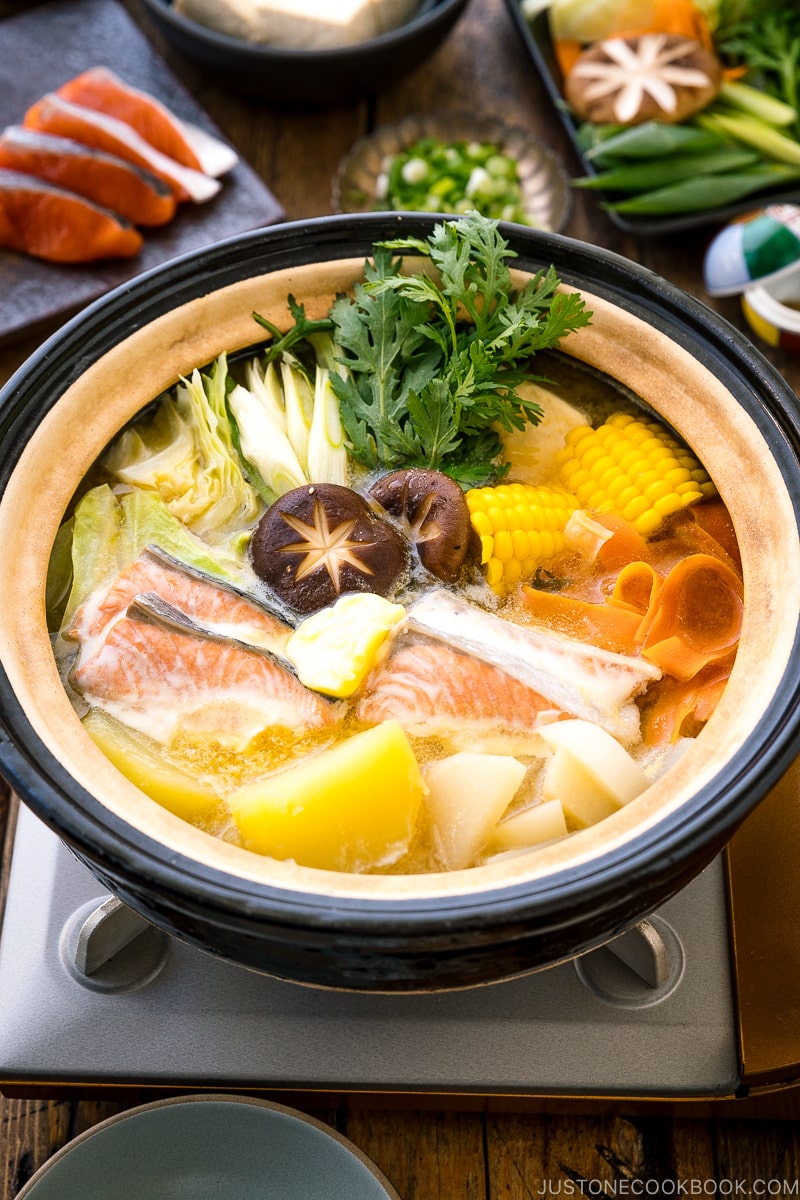
Hot pot weather is here in the Northern Hemisphere! Today, I want to introduce you to a popular regional hot pot dish that highlights fresh seafood and in-season vegetables. Known as Ishikari Nabe (石狩鍋), this Salmon Hot Pot is a must-try comfort food from Hokkaido, Japan.
The dish features some unusual ingredients that are not seen in a typical hot pot. Can you guess? Let’s take a look!
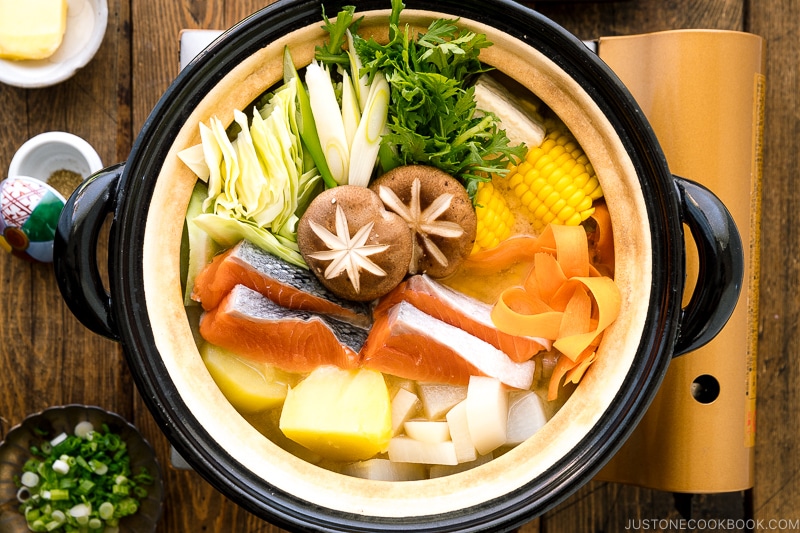
Ishikari Nabe – Hokkaido’s Regional Hot Pot
Ishikari nabe (石狩鍋) is a hot pot meal native to Hokkaido and it utilizes local ingredients like fresh salmon (sometimes trout), onion, potatoes, daikon, cabbage, and corn. The soup stock is made from locally cultivated kombu and seasoned with miso.
A hot pot specialty restaurant called Kindaitei (金大亭) in Ishikari City created this hot pot in the Meiji era. It was a meal for the fishermen who caught fresh salmon in Ishikari River (sounds similar to the popular seafood stew Cioppino made for fishermen in San Francisco!).
The restaurant cooked chopped-up salmon in a white miso-based soup and added local potatoes, onion, and cabbage. They are considered Western vegetables and definitely not your typical hot pot ingredients!
In Hokkaido, Ishikari nabe is served in many restaurants and also at home. Everyone cooks it slightly differently so the flavor and ingredients vary, but all Ishikari nabe is always cooked with salmon or trout and vegetables in a miso-based broth.
Is This Similar to Sanpeijiru?
For those who are familiar with Hokkaido cuisine, you might have already heard of sanpeijiru (三平汁).
Sanpeijiru is more like a soup made with raw salted salmon (instead of raw salmon in Ishikari nabe), potatoes, and daikon. The soup stock is made with salmon scraps (bones, belly, head, etc.) and seasoned with just salt. No addition of miso in sanpeijiru.
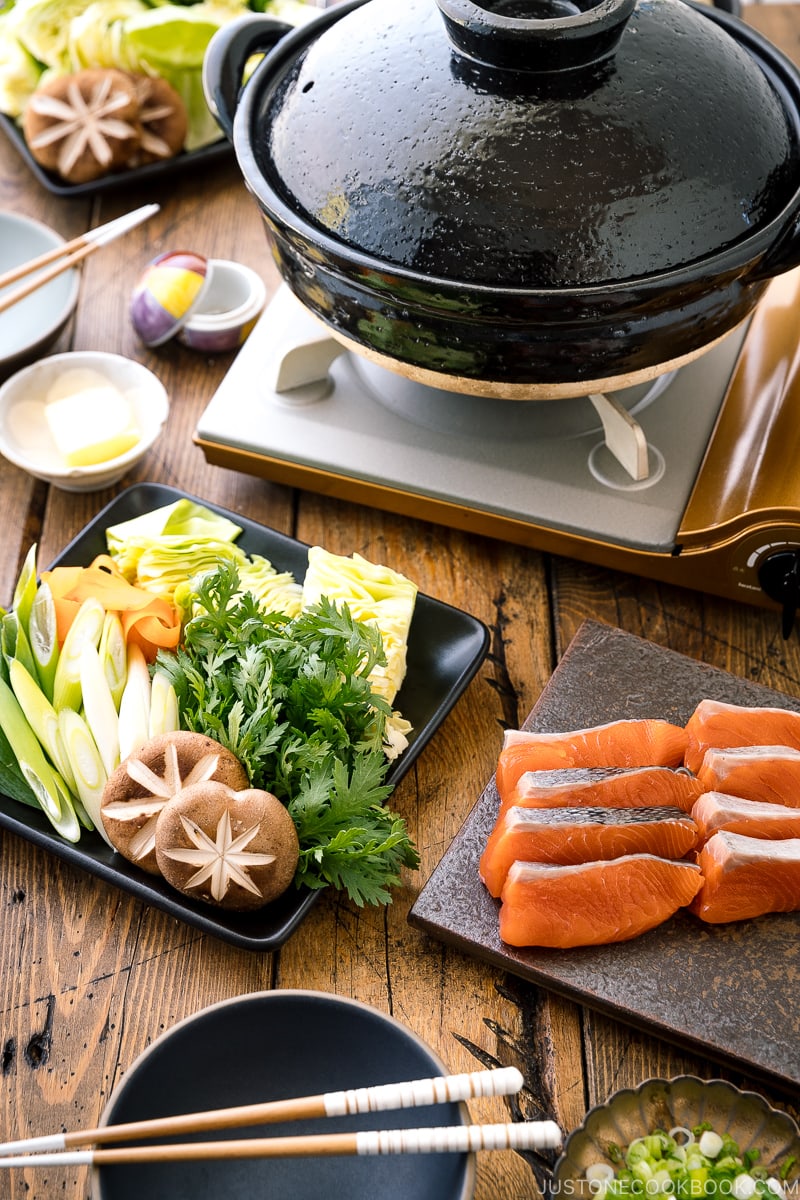
Ingredients for Hokkaido Salmon Hot Pot
- Salmon
- Potatoes
- Onion
- Daikon radish
- Corn
- Carrot
- Cabbage
- Chrysanthemum leaves
- Negi (long green onion)
- Shiitake Mushrooms
- Tofu
- The Broth – kombu dashi
- The Miso Sauce– miso, mirin, sake, and soy sauce.
Another unique ingredient added to the hot pot is butter! Hokkaido is well-known for its delicious and high-quality dairy products. You would add a thick pat of butter on top of the hot pot after the ingredients are cooked. The butter melts away quickly, giving the broth a rich, creamy, and mildly sweet flavor.
The sansho pepper powder (山椒) is typically served at the table for sprinkling over individual serving. This strong fragrance and flavor are known to mask the fishy smell.
Some variations of Ishikari nabe include sake lees (sake kasu) and milk in the hot pot.
Which Miso Is Best for Salmon Hot Pot
For this Ishikari Nabe recipe, I used Organic White Miso from Hikari Miso. I consider the miso my all-rounded condiment as its mellow flavor goes well with almost all recipes, from miso soup to grilled fish to salad dressing.
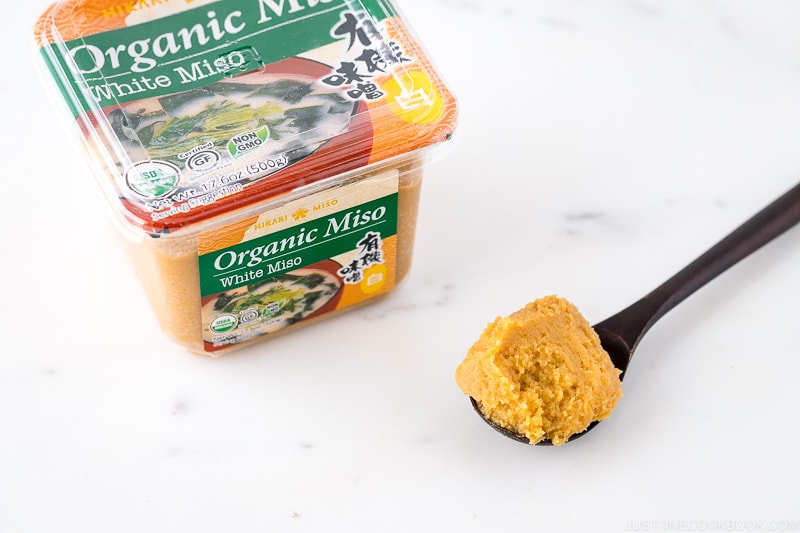
Luckily, according to our readers living in different parts of the world, this miso is widely available in many local Japanese or Asian grocery stores. If not, Amazon also carries this miso.
If you already have a tub of miso in your refrigerator, you can use it too. The flavor profile will be slightly different as each miso type has different saltiness and flavors. However, I would avoid using hatcho miso or saikyo miso as they have a unique taste and may not work well in this hot pot.
How to Make Hokkaido Salmon Hot Pot
- Cut all the ingredients and make the miso sauce.
- Cook hard vegetables in kombu dashi for 10-15 minutes.
- Season the broth with miso-based sauce.
- Bring the donabe to the table along with the platters of ingredients.
- Cook salmon and the rest of vegetables for 10 minutes and enjoy!
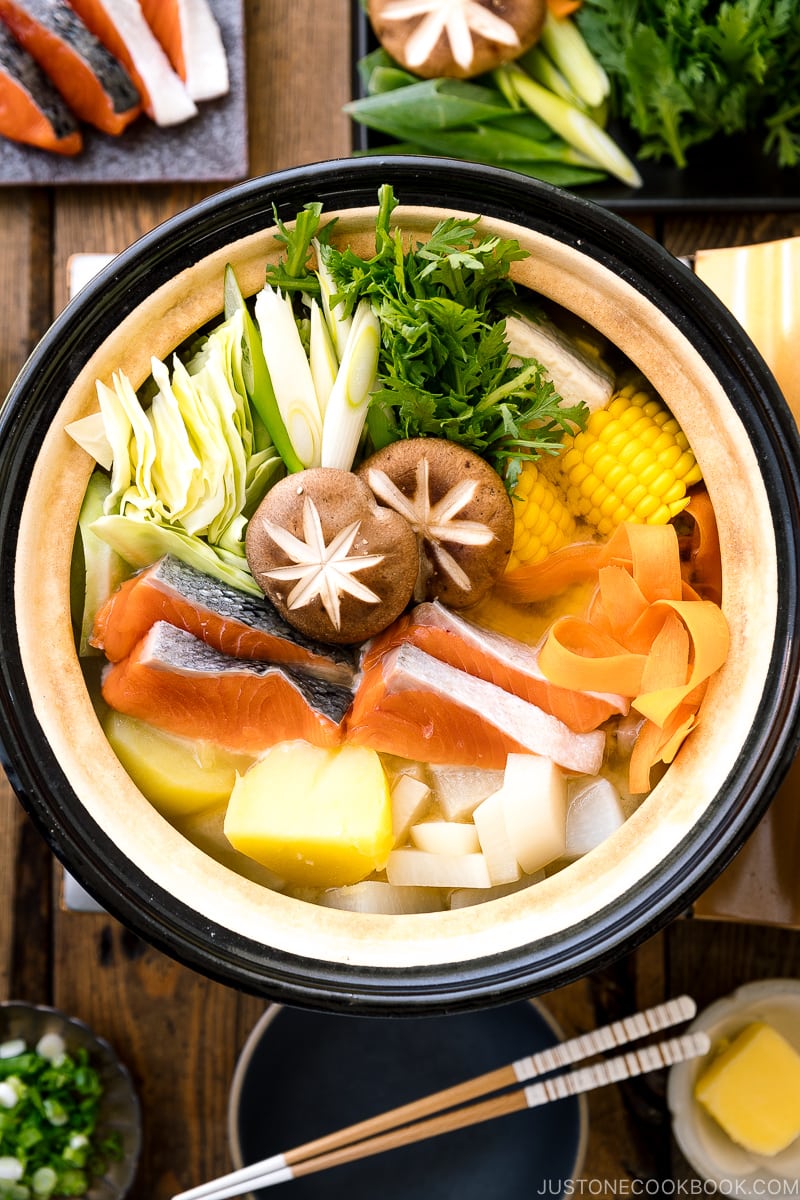
How to Enjoy Salmon Hot Pot – Cooking in 2 Stages
Cooking in the Kitchen
We normally cook all ingredients in the hot pot over the portable stove on the dining table. For Salmon Hot Pot, however, I recommend pre-cooking any root vegetables first for 10-15 minutes before bringing the pot to the table.
Root vegetables such as potatoes, onion, and daikon take some time to cook, so give them a head start.
Cooking at the Table
After you finish cooking the hard vegetables, set up the portable stove at the table and bring the pot over. Prepared ingredients should be on a large platter or smaller plates and placed around the hot pot. You also need to bring out communal cooking utensils (ladle, fine-mesh skimmer, long cooking chopsticks, etc.) and individual bowls.
When everyone is at the table, add the rest of the ingredients to the pot and cook for 10 minutes, or until each ingredient is cooked through. While waiting, people can enjoy small side dishes along with drinks.
Typically, there are more ingredients than they can fit in the pot, so add them to the pot in stages as you eat in. There are no official “hot pot rules,” but it is courteous to take out and divide all the cooked food before adding raw or uncooked ingredients to the same pot. It is also considered a kind gesture to pick up some food from the pot and serve it to the person sitting near you.
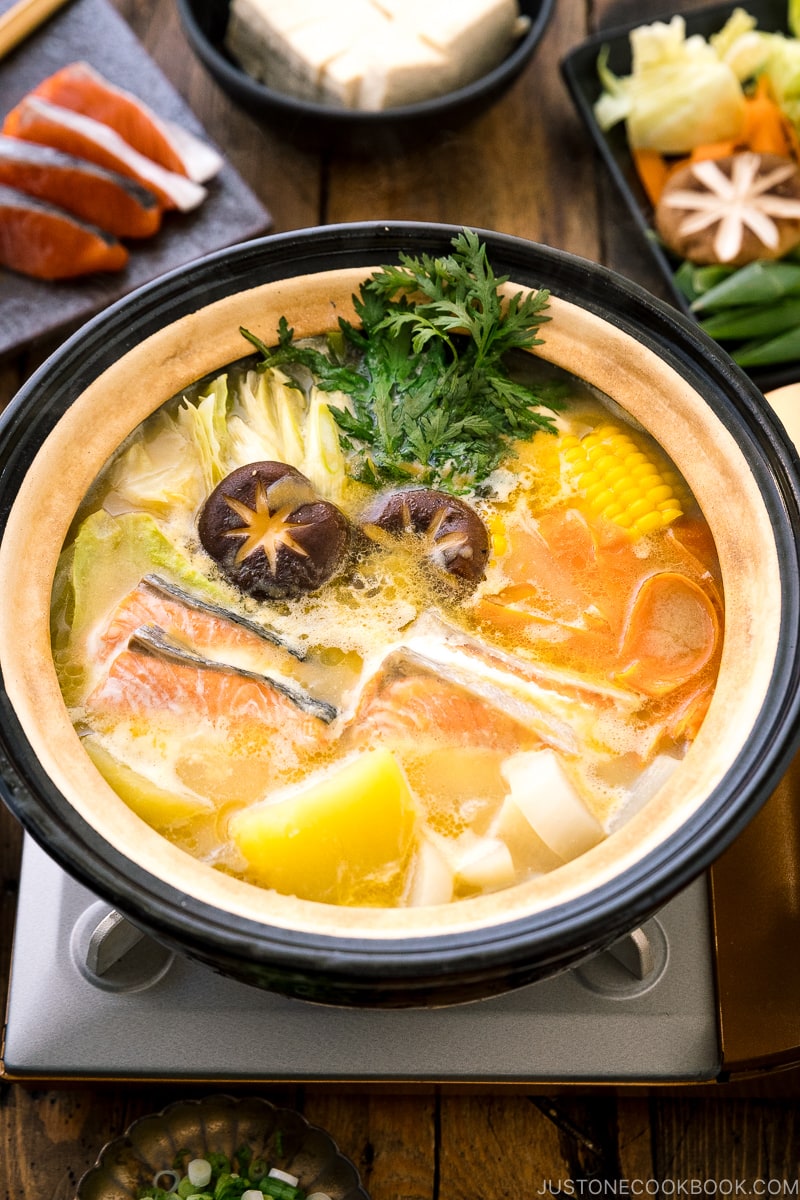
A Few Tips on Cooking Hokkaido Salmon Hot Pot
- First, make a smooth miso sauce in a separate bowl instead of dissolving it directly into the soup broth. This eliminates any chunks of miso paste.
- Remove kombu right before boiling. Kombu releases bitterness and sliminess when you leave it in the broth. If you want more flavor, I recommend cold-brewing kombu dashi. Then slowly heat up to extract more flavor. The used kombu can be repurposed to make Simmered Kombu or Homemade Furikake (rice seasoning).
- Skim the foam and scum on the surface of the broth for a cleaner, sophisticated taste.
- Add more miso sauce as ingredients continue to release moisture and dilute the soup flavor.
- Lastly, when the soup is running low, add water (or kombu dashi). Adjust the broth by adding more miso.
More Hot Pot Recipes You’ll Enjoy
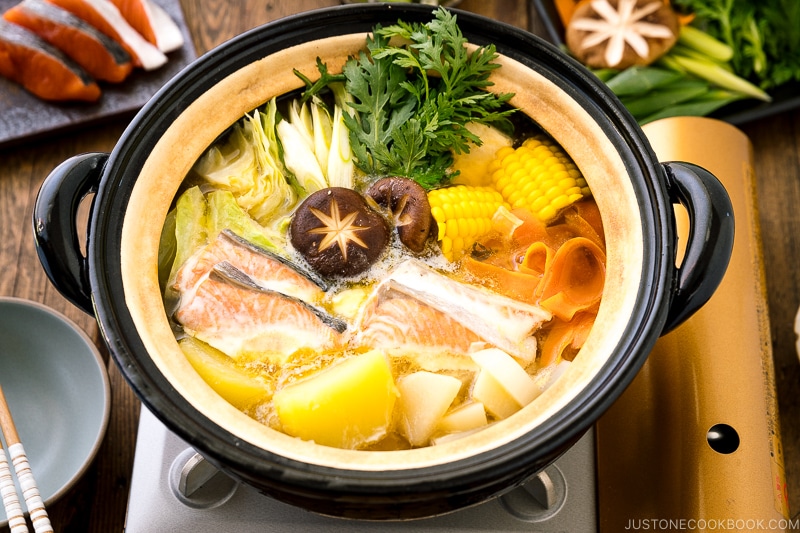
Wish to learn more about Japanese cooking? Sign up for our free newsletter to receive cooking tips & recipe updates! And stay in touch with me on Facebook, Pinterest, YouTube, and Instagram.

Hokkaido Salmon Hot Pot (Ishikari Nabe)
Ingredients
For the Soup Broth
- 4 cups water
- 1 piece kombu (dried kelp) (8 g; 2 x 5 inches, 5 x 13 cm per piece)
- ¼ tsp Diamond Crystal kosher salt (to taste)
For the Hot Pot Ingredients
- 2 skin-on salmon fillets (¾ lb, 340 g; skip for vegan/vegetarian)
- ¼ tsp Diamond Crystal kosher salt (for the salmon)
- 2 Yukon gold potatoes (13 oz, 400 g; Yukon gold potatoes are firmer and retain their shape after cooking; russet potatoes may dissolve into the broth)
- ½ lb daikon radish (2 inches, 5 cm)
- ½ onion (¼ lb, 113 g)
- 1 ear sweet corn (6 oz, 170 g)
- ½ head green cabbage (15 oz, 425 g)
- 1 carrot (1.8 oz, 50 g)
- 1 bunch shungiku (chrysanthemum greens) (3.5 oz, 100 g)
- 4 shiitake mushrooms (2.5 oz, 70 g)
- 1 Tokyo negi (naga negi; long green onion) (1.4 oz, 40 g)
- 1 medium-firm tofu (momen dofu) (14 oz, 397 g)
For Serving
- 2 Tbsp unsalted butter (skip for vegan/vegetarian)
- Japanese sansho pepper
Instructions
- Gather all the ingredients.

To Make The Soup Broth
- In a large pot (I use a donabe), soak 1 piece kombu (dried kelp) in 4 cups water and set it aside. To extract more flavor, you can do this step several hours in advance (up to overnight; but keep it cool or store it in the refrigerator if you live in a hot environment).

To Prepare the Hot Pot Ingredients
- Check to see if there are any bones left in the 2 skin-on salmon fillets. Remove if you find them (I use fish bone tweezers). Cut the fillets into 2-inch (5-cm) pieces and ½-inch thickness.

- Season both sides of the salmon with ¼ tsp Diamond Crystal kosher salt. Keep it refrigerated while you prepare other ingredients.

- Peel 2 Yukon gold potatoes and cut them into quarters. Then soak them in water to remove starch.

- Cut ½ lb daikon radish in quarters lengthwise, and then cut them into ⅜-inch (1-cm) slices.

- Cut ½ onion into wedges and set aside.

- Cut 1 ear sweet corn into 4 pieces and set aside.

- Cut ½ head green cabbage in half (so now it‘s ¼ of the whole cabbage) and discard the core by slicing it off. Then cut the cabbage into 2-inch (5-cm) pieces and set aside.

- With a vegetable peeler, remove the outer skin of 1 carrot. Then using the same peeler, continue to peel the carrot. Alternatively, you can slice the carrot into ½-inch (1.3-cm) thickness. Set aside.

- Discard the bottom ends of 1 bunch shungiku (chrysanthemum greens). Cut them into 2-inch (5-cm) pieces and set them aside.

- Discard the stems of 4 shiitake mushrooms. You can add a decorative flower cut.

- Cut 1 Tokyo negi (naga negi; long green onion) diagonally into ½-inch (1.3-cm) thickness. Cut 1 medium-firm tofu (momen dofu) into bite-size pieces.

To Make the Miso Sauce
- In a small bowl, combine 5–6 Tbsp miso, 4 Tbsp sake, 2 Tbsp mirin, and 1 tsp soy sauce and mix it all together.

To Pre-Cook the Hot Pot in the Kitchen
- The kombu in the donabe should be rehydrated in water (this is kombu dashi). Add the potatoes, daikon radish, and corn into the broth.

- Cover the donabe and bring the broth to a gentle simmer over medium heat. Discard the kombu (you can repurpose the used kombu to make simmered kombu or homemade furikake rice seasoning).

- Cover and continue to cook for 10–15 minutes until a wooden skewer goes through daikon radish.

- Add two-thirds of the miso sauce into the hot pot broth and mix well. Set aside the rest of the miso sauce and add it to the broth after everything is cooked through.

- Taste the broth. If you want a stronger miso flavor, add more miso. Instead of dropping the miso into the broth, take out a small portion of the broth into a bowl, add miso, and let it dissolve completely before returning back to the broth. Season the broth with ¼ tsp Diamond Crystal kosher salt to your taste.

To Cook the Hot Pot at the Table
- Set up the table with a portable stove, platters of ingredients, individual bowls, and cooking utensils (long chopsticks, a ladle, and a fine-mesh skimmer). Add some of the ingredients to the donabe and cover to cook for 10 minutes.

- Once all the ingredients are cooked through, add the rest of the miso sauce and put 2 Tbsp unsalted butter on top. Pick up the cooked ingredients and serve in individual bowls to enjoy. Sprinkle Japanese sansho pepper to your taste. Once the hot pot is almost empty, add the next batch of ingredients and continue cooking and eating.

To Store
- You can keep the leftover salmon hot pot in an airtight container and store it in the refrigerator for 2 days.
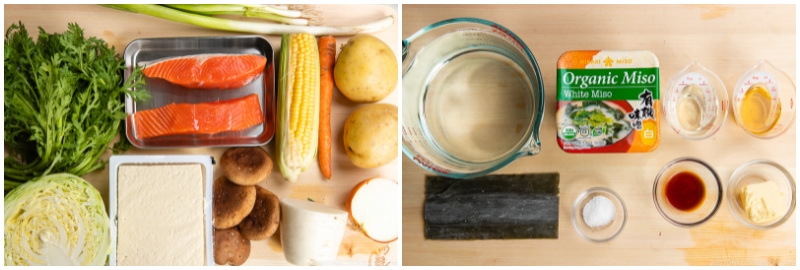
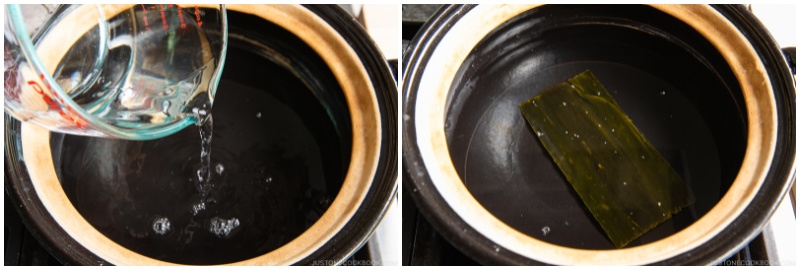
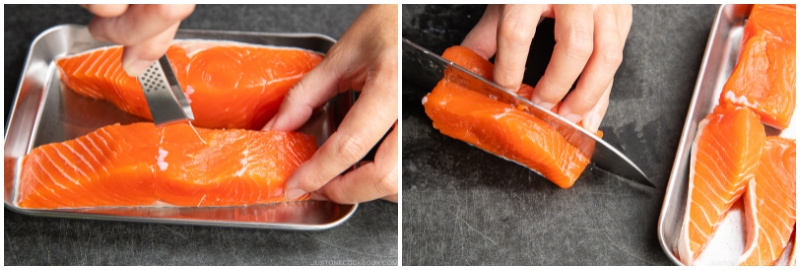
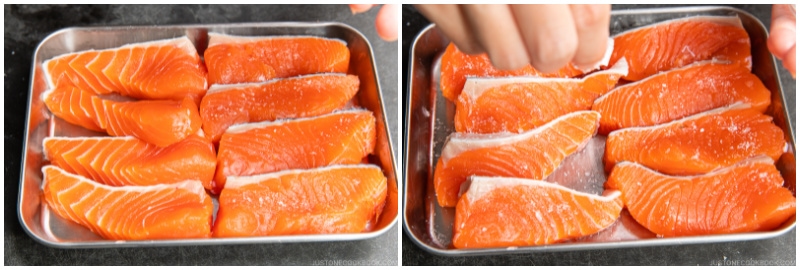
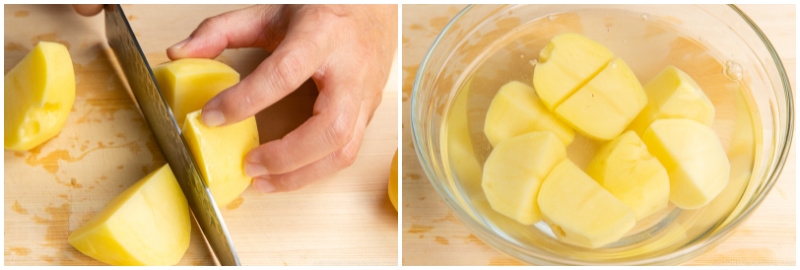
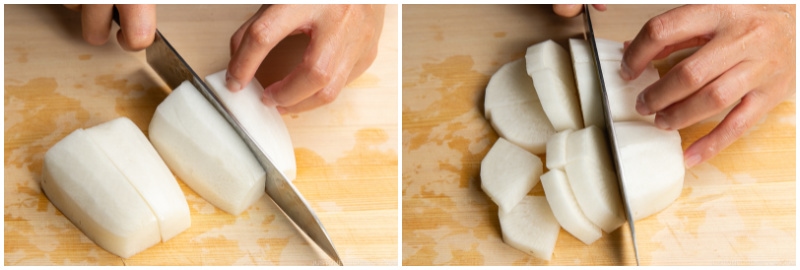
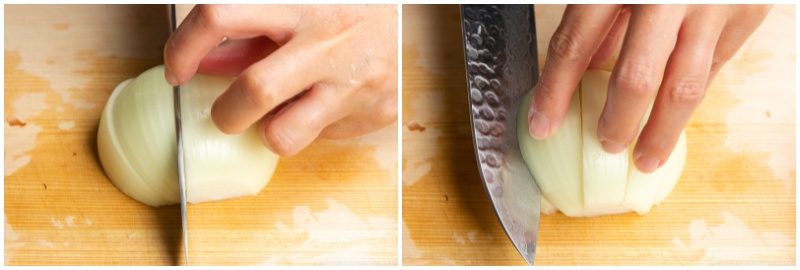
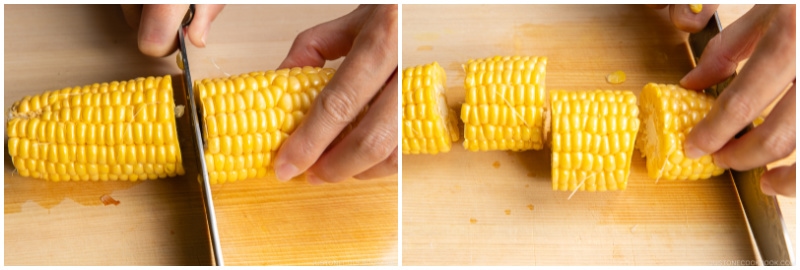
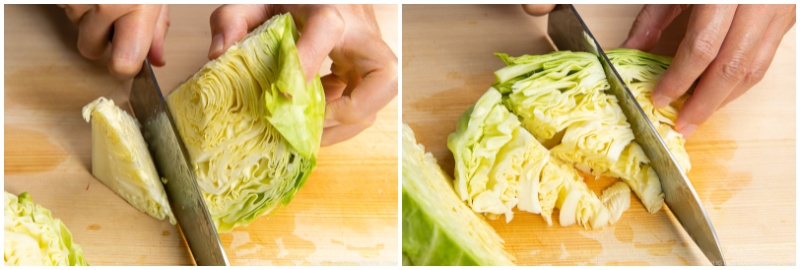
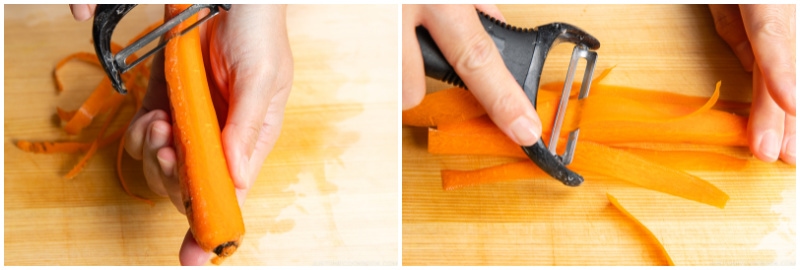

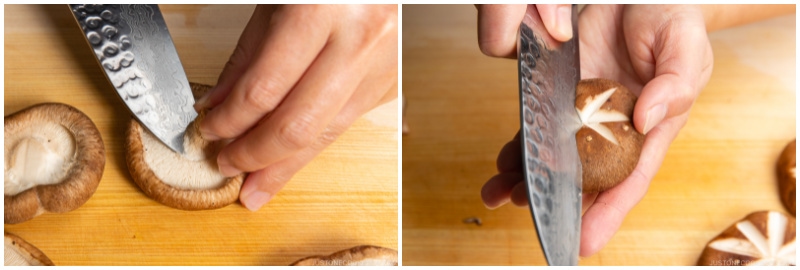
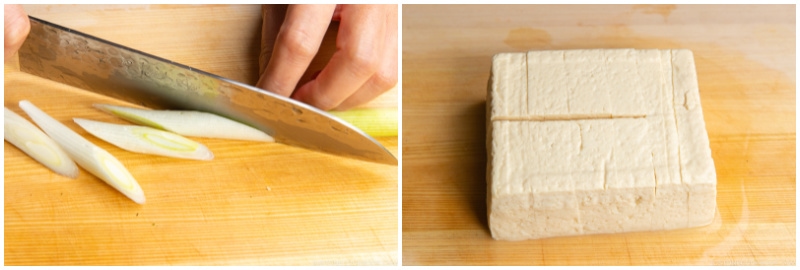
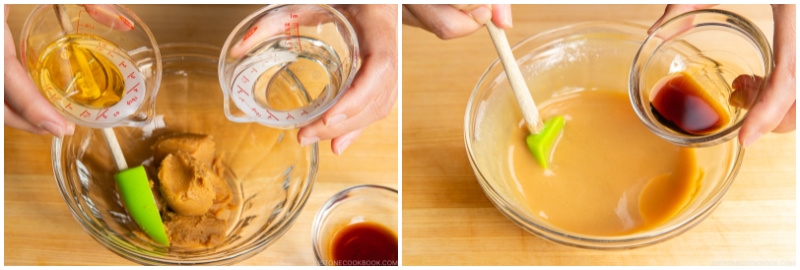

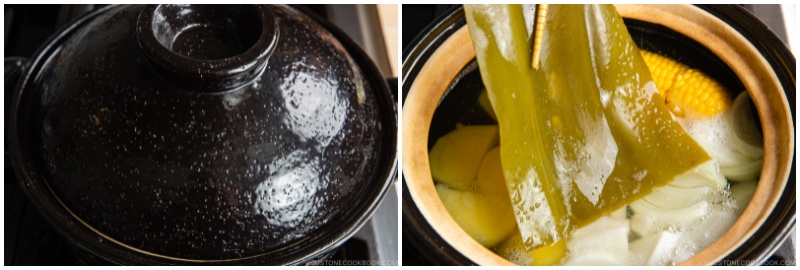
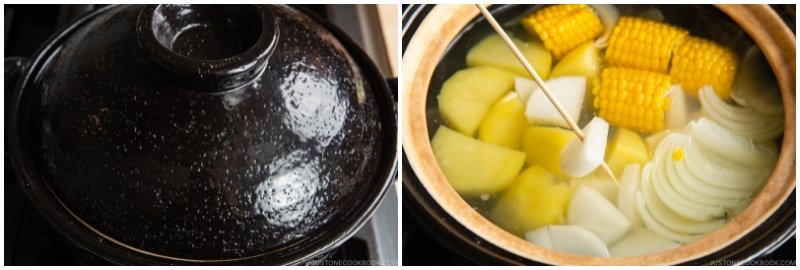
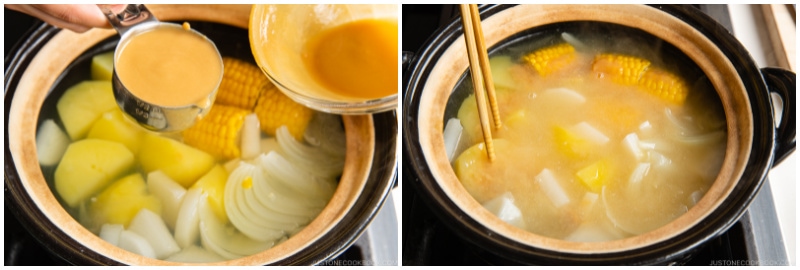
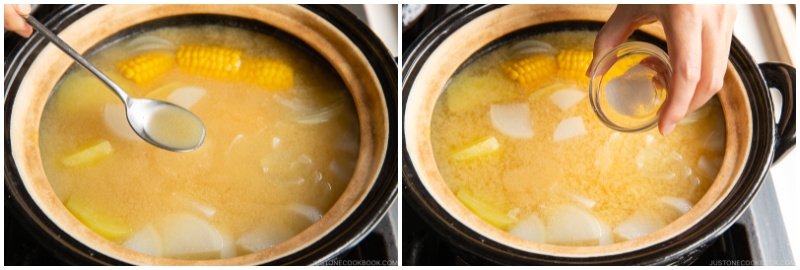
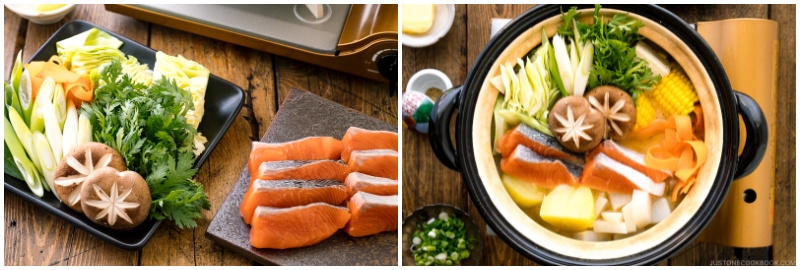










Oishee!!!!! I chose this recipe for my (Japanese) husband to make for company, and it was so delicious! I’m not a big Nabe fan, because I prefer a more flavored broth, and so this was amazing. He reports that it was easy to make, and really appreciated the tip about cold brewing the kombu. Thank you JOC!
Hi Robin! We are so happy to hear you and your husband enjoyed Nami’s recipe!
Thank you so much for trying her recipe and for your kind feedback. Happy Cooking!
Thank you for the recipe. It’s quite easy to prepare and all cook in a pot which nowadays I like this cooking method. I didn’t have the shingiku vegetables and omitted the potatoes. It tasted good and I’m sure it would taste even better with the vegetables…. I couldn’t find it in my country. My husband enjoy the nabe very much too. Thanks!
Hi, Indy! Thank you very much for trying Nami’s recipe!
We’re delighted to hear you and your husband enjoyed it.
Nami has a variety of Nabe recipes, so we hope you will check out the rest.☺️
https://www.justonecookbook.com/tags/hot-pot/
Hi, in the post you say that this recipe can also be made with trout. So can I just replace the salmon with trout? And should I remove the bones before cooking (I find that quite difficult when the fish is still raw…)?
Hi Hannah! The trout salmon should be sliced into fillet, like the salmon shown here. It’s easier to remove the bones from a fillet with a bone tweezer (https://amzn.to/4625pf2).
A bit of a tangent, but I noticed you have some staining in the photos on the top where the lid goes, where the glaze ends. I have a similar thing on my Kamado-san. Is there a good way to clean that?
Hi Ben! Thank you for reading Nami’s post!
You may try the baking powder method or fill the pot with water and add a few tablespoons of vinegar. When it reaches the boiling point, remove it from the heat and set it aside to cool. Scrub the stain gently with a soft sponge.
Here is the post about how to take care of your Donabe. We hope this helps!
https://www.justonecookbook.com/how-to-season-your-donabe/
I know it’s not likely, but can this be prepared in a pot on a stove rather than in a donabe? It looks so nice but I don’t have the set up for a proper hot pot!
Hi Rachel, thank you for reading Nami’s post! You can make this hot pot dish in a regular pot and cook it on the stove.🤗
Hello, can you recommend a portable stove?
Hi Karen! Thank you very much for trying Nami’s recipe!
Nami recommends this portable stove: https://www.amazon.com/dp/B013U7AUA4?ref=exp_justonecookbook_dp_vv_d
We hope this helps!
I love hot pot and miso. However, one of my kids has soy allergy so I can’t use miso at all. I am wondering what I can replaced with miso? Or can I not add miso?
Would it be good if I use fish stock as base?
Hi Maycal! Thank you very much for reading Nami’s post and trying her recipe!
Yes, you can skip miso and adjust the flavor with salt. As for the broth, Salmon and Kombu dashi makes good stock already, so you do not need to add fish stock.
To have more flavor, you can make a dipping sauce like ponzu to enjoy this hot pot if you like.
We hope this helps!
I’m interested in buying a donabe, and am looking at several from Musubi Kiln. But I am unsure which is the better shape/size. If I could only buy one pot, should I select the rice cooker (to also be used for hot pot dishes, soup, curry, cheese fondue, etc.), or should I select the shallow “regular” donabe for hot pot dishes (and also use it as a rice cooker)?
I like the rice cooker because it is a deeper pot. But the “regular” donabe seems like it would be perfect for hot pot dishes such as this salmon recipe. I would like to have a versatile pot!
Hi Christina! Thank you very much for reading Nami’s post and trying her recipe!
It is nice to have two different types of Donabe, as you mentioned. But if it has to be only one pot, we recommend a 12 inch (30 cm) Donabe (9-Go, 9号) for 4-5 people, like this one. https://amzn.to/35oQhfu
We hope this helps!
Doesn’t the kombu become slimy if left overnight? I let it soak for couple of hours and it was.
Hi Jean! Thank you very much for reading Nami’s post and trying her recipe!
The Kombu gets slimy quickly depending on the type of Kombu, water, and the weather. If you plan to soak them overnight, please place them in the refrigerator (Cold Brew). https://www.justonecookbook.com/how-to-make-kombu-dashi-vegetarian-dashi/
We hope this helps!🙂
My favorite!! Can’t wait to make it!
Hi Van! Thank you very much for reading Nami’s post!
We hope you enjoy Ishikari Nabe!😊